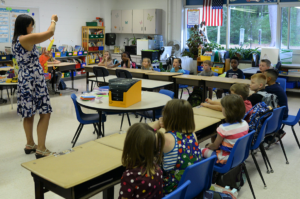The perilous state of Santa Ana schools
 Class conflict: Santa Ana schools are spending more and more on fewer students. (U.S. Air Force file photo)
Class conflict: Santa Ana schools are spending more and more on fewer students. (U.S. Air Force file photo)
School officials in California’s sixth-largest school district are working overtime to promote a massive $1.2 billion bond tentatively scheduled for a districtwide vote in November. Yet behind their chatter about improving Santa Ana Unified facilities is a stark fact: Student enrollment there has been falling steadily for over 15 years. And declining enrollment means declining revenue from federal, state and local sources – about $10,000 per student. But at the same time, district spending, particularly on teacher salaries and benefits, has been rising. Where those two trends intersect – falling revenue, rising costs– is crisis.
Just last summer, the crisis claimed its first victims when the district declared it would have to lay off 287 teachers. The same teacher’s union that had pushed for the pay increases that precipitated the crisis helpfully provided district officials with the hit list – all of it based on one metric only: the last hired were the first fired.
But the crisis didn’t begin in 2017. An SAUSD demographer’s 2016 report illustrates a steady decline in SAUSD enrollment starting in 2003. That year, total student enrollment was 60,973. By 2012, enrollment had fallen to 53,493. This equates to an approximately 12% drop in enrollment and a $75 million loss in revenue. Long-range projections through this school year predict that the decline will continue.
As recently as June 26th — school trustees backed by the powerful teaches union approved regular annual salary increases. In addition to this most recent salary increase, teacher salaries were also raised from 2013-2015.
Losing cash, union-backed trustees ordered district staff to find a solution. Facilities maintenance was delayed. Major renovations were impossible. And so they settled on the November bond.
A bond is basically an IOU — the district’s promise that it will repay Wall Street lenders interest on a multi-million-dollar loan. District officials first pegged the amount of the loan at $479 million – enough, they said, to repair damage created by time and mismanagement. But in the past few weeks the amount of the bond has fluctuated from $518 million back down to $232 million. Neither figure includes interest payments on the loan, which will more than double its cost.
Santa Ana Unified hasn’t even finished paying off two existing loans, from 1999 and 2008. They should be paid off by 2040. By that time, last month’s graduates will be about 40 years old, some with children of their own attending Santa Ana schools that will boast well-paid adults, falling test scores, failing infrastructure – and perhaps still laboring beneath hundreds of millions of dollars in repayments on the Great Bond of 2018.
Kelly McGee is a Rhodes College graduate and a journalism intern at California Policy Center.
